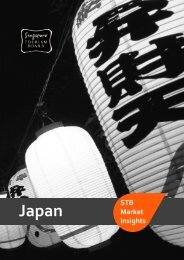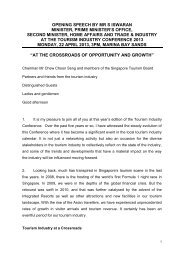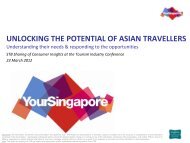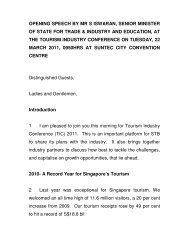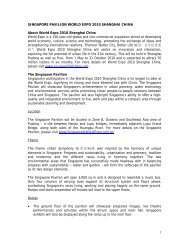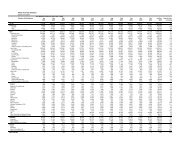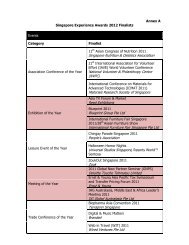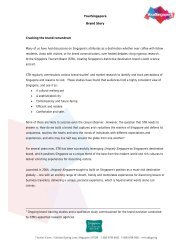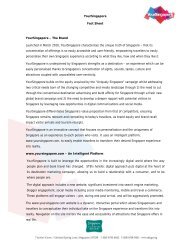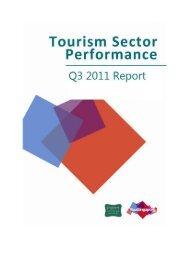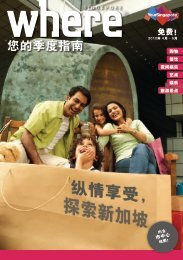i'mpact Singapore Tourism Board Annual Report 2010/2011
i'mpact Singapore Tourism Board Annual Report 2010/2011
i'mpact Singapore Tourism Board Annual Report 2010/2011
You also want an ePaper? Increase the reach of your titles
YUMPU automatically turns print PDFs into web optimized ePapers that Google loves.
<strong>Tourism</strong> Sector Performance<br />
Hotels<br />
Building Towards Design and Personalisation<br />
The average hotel occupancy rate rose by nine percentage<br />
points to 85 per cent for <strong>2010</strong> and the average room rate<br />
increased 14.7 per cent to S$217, despite a 10.6 per cent<br />
jump in room numbers or an addition of more than 4,500<br />
rooms. Total hotel room inventory now stands at over 47,000.<br />
The new hotels that opened in <strong>2010</strong> embodied the creativity<br />
and exciting diversity found throughout <strong>Singapore</strong>’s growing<br />
accommodation sector. Establishments ranging from boutique<br />
to full-service hotels are building on different concepts and<br />
offering quality, singular experiences to create greater value for<br />
discerning guests.<br />
The country’s recent surge in visitor arrivals has precipitated<br />
the need for the hospitality industry to become even more<br />
productive. To meet this rise in demand, the <strong>Singapore</strong><br />
Hotel Association, supported by the Food Drinks and Allied<br />
Workers’ Union and STB, launched Hotel Transformation<br />
<strong>2010</strong>. This initiative brought over 70 hotels together in a<br />
pledging ceremony to formalise their commitment towards<br />
strengthening industry competitiveness by implementing<br />
productivity initiatives.<br />
A hotel productivity plan was subsequently introduced<br />
to increase the sector’s core capabilities and reduce its<br />
dependence on low-skilled foreign labour. This plan will tackle<br />
key challenges such as raising the value and attractiveness<br />
of hotel-related jobs for a better-skilled workforce, improving<br />
service quality and ensuring continuous improvements to<br />
sustain the sector’s development in the long run.<br />
The newly opened Fullerton Bay Hotel adds to the diversity of <strong>Singapore</strong>’s<br />
hospitality offerings.<br />
Sector Development<br />
Service comes first<br />
Going even further for service is the second phase of the<br />
“Go the Extra Mile for Service” (GEMS Up) movement.<br />
Represented by SPRING <strong>Singapore</strong>, STB, the <strong>Singapore</strong><br />
Workforce Development Agency, the Institute of Service<br />
Excellence at the <strong>Singapore</strong> Management University and<br />
the National Trades Union Congress, GEMS Up focuses on<br />
service research, thought leadership, capability development<br />
and promotion and recognition.<br />
This drive for greater service awareness brought about Can<br />
You Serve, the world’s first reality TV series to pit contestants’<br />
customer service skills against each other. Making its debut in<br />
June <strong>2010</strong>, the eight-part series saw nine contestants compete<br />
in various challenging roles across different service-oriented<br />
industries for the top prize of S$70,000 in cash and S$30,000<br />
in training opportunities. As a joint initiative between activeTV<br />
and the GEMS Up movement and supported by the Restaurant<br />
Association of <strong>Singapore</strong>, <strong>Singapore</strong> Hotel Association and<br />
<strong>Singapore</strong> Retailers Association, Can You Serve showcased<br />
40




